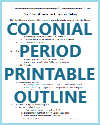Unit II: Colonial Period Outlines and PowerPoints |
|---|
| www.studenthandouts.com > U.S. History > Colonial Period > Outlines and PowerPoints |
 |
||||||||||
| Colonial Period Outline with Two Versions |
|
Outlines are exceptionally useful for high school students studying the colonial period in American history for numerous reasons.
Organization of Information: The colonial period encompasses a wide range of events, people, and developments. Outlines provide a structured framework for organizing this information chronologically and thematically, making it easier for students to grasp and retain. Clarity and Focus: Outlines break down the complex historical narratives of the colonial era into clear and concise bullet points or sections. This clarity helps students focus on the key topics and concepts without getting overwhelmed by excessive details. Visual Overview: Outlines provide a visual overview of the colonial historical period, allowing students to see the big picture. This visual representation helps students identify the major themes, trends, and connections within the colonial era. Study Aid: Outlines serve as effective study aids for exams and assessments. Students can use them as condensed study guides to review essential information, making exam preparation more efficient. Critical Thinking: Creating outlines requires students to engage in critical thinking as they decide what information to include, how to structure it, and what relationships to emphasize. This process deepens their understanding of the material. This is particularly valuable for students preparing for standardized tests, such as the AP exam on United States history. Note-Taking: Outlines on American colonialism can be a valuable tool during lectures or while reading textbooks and primary sources. They encourage active engagement with the material by summarizing key points in a structured format. Time Management: By breaking down the colonial period into manageable sections, outlines help students allocate their study time effectively. This prevents procrastination and ensures that students cover all relevant topics. Visual Hierarchy: Outlines use a hierarchical structure, with main headings, subheadings, and sub-subheadings, be it King Philip's War or indentured servitude. This hierarchy helps students prioritize information and understand the relative importance of different topics. Flexible Learning: Outlines are flexible and can be adapted to suit various learning styles. Students can customize our free printable colonial period outlines to emphasize areas they find challenging or to accommodate their preferred study methods. Review and Revision: Outlines can be easily revised and updated as students learn more about the colonial period. This adaptability allows students to refine their understanding of United States history as they progress through the course. Comprehensive Coverage: Outlines prompt students to consider all relevant aspects of the colonial period, ensuring they don't overlook critical events, figures, or themes. Collaboration: Outlining can be a collaborative activity. Students can work together to create outlines, share ideas, and ensure that they have a comprehensive overview of the material. Outlines serve as valuable tools for high school students studying the colonial period in American History. They promote organization, clarity, and critical thinking while providing a structured framework for learning and review. Whether used for note-taking, exam preparation, or collaborative learning, these free printable outlines enhance students' comprehension and retention of this historical content. |
| Colonial Period Books and Films | Colonial Period Learning and Study Games |
| Colonial Period Image Galleries | Colonial Period Outlines and PowerPoints |
| Colonial Period Miscellany | Colonial Period Worksheets |
| www.studenthandouts.com > U.S. History > Colonial Period > Outlines and PowerPoints |







